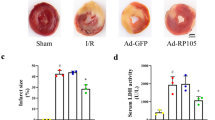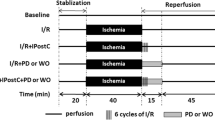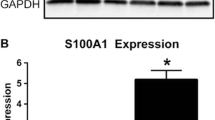Abstract
Cyclic GMP-dependent protein kinase (PKG) is a serine-threonine kinase that mediates the cardioprotective effect of ischemic and pharmacologic preconditioning. Since hydrogen sulfide (H2S) has been implicated in mediating the cardioprotective effects of the cGMP modulators tadalafil and cinaciguat, we tested the hypothesis that myocardial gene therapy with PKG exerts cardioprotection against ischemia/reperfusion (I/R) injury through a mechanism involving H2S. Adult rat cardiomyocytes were infected with adenoviral vector encoding PKGIα or inactive mutant PKGIαK390A (K390A) for 24 h. Necrosis and apoptosis (n = 6/group) were determined after 90 min of simulated ischemia and 1 or 18 h of reoxygenation, respectively. To study the effect of PKGIα in vivo, mice received intramyocardial injections of adenoviral PKGIα or K390A. Four days later, the hearts were subjected to 30 min of ischemia followed by reperfusion for 24 h. The inhibitor of H2S-producing enzyme, cystathionine-γ-lyase (CSE), dl-propargylglycine (PAG, 50 mg/kg, ip) was given 30 min before ischemia. PKGIα overexpression induced CSE expression, whereas cystathionine-β-synthase (CBS) and 3-mercaptopyruvate sulfurtransferase expression was not changed. PKGIα overexpression increased H2S in the heart and cardiomyocytes in relation to control and PKGIαK390A. Moreover, PAG abolished protection with PKGIα in vitro by increasing necrosis (35.2 ± 1.7 %, P < 0.05) and apoptosis (23.5 ± 1.8 %, P < 0.05) as compared to PKGIα-overexpressing cells (necrosis: 17.2 ± 0.9 % and apoptosis: 13.2 ± 0.8 %). In vivo, PKGIα overexpression reduced infarct size and preserved left ventricular fractional shortening as compared with K390A (P < 0.05) and PAG abolished the cardioprotective effect of PKGIα. The protective effect of myocardial gene therapy with PKGIα against I/R injury is mediated through a mechanism involving H2S signaling.








Similar content being viewed by others
References
Altaany Z, Moccia F, Munaron L, Mancardi D, Wang R (2014) Hydrogen sulfide and endothelial dysfunction: relationship with nitric oxide. Curr Med Chem 21:3646–3661. doi:10.2174/0929867321666140706142930
Bibli SI, Yang G, Zhou Z, Wang R, Topouzis S, Papapetropoulos A (2015) Role of cGMP in hydrogen sulfide signaling. Nitric Oxide 46:7–13. doi:10.1016/j.niox.2014.12.004
Bice JS, Baxter GF (2014) Postconditioning signaling in the heart: mechanisms and translatability. Br J Pharmacol. doi:10.1111/bph.12976
Burgoyne JR, Prysyazhna O, Rudyk O, Eaton P (2012) cGMP-dependent activation of protein kinase G precludes disulfide activation: implications for blood pressure control. Hypertension 60:1301–1308. doi:10.1161/HYPERTENSIONAHA.112.198754
Burgoyne JR, Oka S, Ale-Agha N, Eaton P (2013) Hydrogen peroxide sensing and signaling by protein kinases in the cardiovascular system. Antioxid Redox Signal 18:1042–1052. doi:10.1089/ars.2012.4817
Burley DS, Ferdinandy P, Baxter GF (2007) Cyclic GMP and protein kinase-G in myocardial ischaemia-reperfusion: opportunities and obstacles for survival signaling. Br J Pharmacol 152:855–869. doi:10.1038/sj.bjp.0707453
Calvert JW, Elston M, Nicholson CK, Gundewar S, Jha S, Elrod JW, Ramachandran A, Lefer DJ (2010) Genetic and pharmacologic hydrogen sulfide therapy attenuates ischemia-induced heart failure in mice. Circulation 122:11–19. doi:10.1161/CIRCULATIONAHA.109.920991
Cen B, Deguchi A, Weinstein IB (2008) Activation of protein kinase G Increases the expression of p21CIP1, p27KIP1, and histidine triad protein 1 through Sp1. Cancer Res 68:5355–5362. doi:10.1158/0008-5472.CAN-07-6869
Chau VQ, Salloum FN, Hoke NN, Abbate A, Kukreja RC (2011) Mitigation of the progression of heart failure with sildenafil involves inhibition of RhoA/Rho-kinase pathway. Am J Physiol Heart Circ Physiol 300:H2272–H2279. doi:10.1152/ajpheart.00654.2010
Cohen MV, Downey JM (2014) Signalling pathways and mechanisms of protection in pre- and postconditioning: historical perspective and lessons for the future. Br J Pharmacol. doi:10.1111/bph.12903
D’Souza SP, Yellon DM, Martin C, Schulz R, Heusch G, Onody A, Ferdinandy P, Baxter GF (2003) B-type natriuretic peptide limits infarct size in rat isolated hearts via KATP channel opening. Am J Physiol Heart Circ Physiol 284:H1592–H1600. doi:10.1152/ajpheart.00902.2002
Das A, Salloum FN, Xi L, Rao YJ, Kukreja RC (2009) ERK phosphorylation mediates sildenafil-induced myocardial protection against ischemia-reperfusion injury in mice. Am J Physiol Heart Circ Physiol 296:H1236–H1243. doi:10.1152/ajpheart.00100.2009
Das A, Salloum FN, Xi L, Rao YJ, Kukreja RC (2009) Role of ERK1/2 phosphorylation in sildenafil-induced myocardial protection against ischemia-reperfusion injury in mice. Am J Physiol Heart Circ Physiol 296:H1236–H1243. doi:10.1152/ajpheart.00100.2009
Das A, Smolenski A, Lohmann SM, Kukreja RC (2006) Cyclic GMP-dependent protein kinase Ialpha attenuates necrosis and apoptosis following ischemia/reoxygenation in adult cardiomyocyte. J Biol Chem 281:38644–38652. doi:10.1074/jbc.M606142200
Das A, Xi L, Kukreja RC (2005) Phosphodiesterase-5 inhibitor sildenafil preconditions adult cardiac myocytes against necrosis and apoptosis: essential role of nitric oxide signaling. J Biol Chem 280:12944–12955. doi:10.1074/jbc.M404706200
Das A, Xi L, Kukreja RC (2008) Protein kinase G-dependent cardioprotective mechanism of phosphodiesterase-5 inhibition involves phosphorylation of ERK and GSK3beta. J Biol Chem 283:29572–29585. doi:10.1074/jbc.M801547200
Elrod JW, Calvert JW, Morrison J, Doeller JE, Kraus DW, Tao L, Jiao X, Scalia R, Kiss L, Szabo C, Kimura H, Chow CW, Lefer DJ (2007) Hydrogen sulfide attenuates myocardial ischemia-reperfusion injury by preservation of mitochondrial function. Proc Natl Acad Sci USA 104:15560–15565. doi:10.1073/pnas.0705891104
Francis SH, Corbin JD (1999) Cyclic nucleotide-dependent protein kinases: intracellular receptors for cAMP and cGMP action. Crit Rev Clin Lab Sci 36:275–328. doi:10.1080/10408369991239213
Geng B, Yang J, Qi Y, Zhao J, Pang Y, Du J, Tang C (2004) H2S generated by heart in rat and its effects on cardiac function. Biochem Biophys Res Commun 313:362–368. doi:10.1016/j.bbrc.2003.11.130
Gotz KR, Sprenger JU, Perera RK, Steinbrecher JH, Lehnart SE, Kuhn M, Gorelik J, Balligand JL, Nikolaev VO (2014) Transgenic mice for real-time visualization of cGMP in intact adult cardiomyocytes. Circ Res 114:1235–1245. doi:10.1161/CIRCRESAHA.114.302437
Han J, Kim N, Kim E, Ho WE, Earm YE (2001) Modulation of ATP-sensitive potassium channels by cGMP-dependent protein kinase in rabbit ventricular myocytes. J Biol Chem 276:22140–22147. doi:10.1074/jbc.M010103200
Hofmann F, Ammendola A, Schlossmann J (2000) Rising behind NO: cGMP-dependent protein kinases. J Cell Sci 113:1671–1676
Hou J, Kang YJ (2012) Regression of pathological cardiac hypertrophy: signaling pathways and therapeutic targets. Pharmacol Ther 135:337–354. doi:10.1016/j.pharmthera.2012.06.006
Ishii I, Akahoshi N, Yu XN, Kobayashi Y, Namekata K, Komaki G, Kimura H (2004) Murine cystathionine gamma-lyase: complete cDNA and genomic sequesnces, promoter activity, tissue distribution and developmental expression. Biochem J 381:113–123
Keilbach A, Ruth P, Hofmann F (1992) Detection of cGMP dependent protein kinase isozymes by specific antibodies. Eur J Biochem 208:467–473. doi:10.1111/j.1432-1033.1992.tb17209.x
King AL, Polhemus DJ, Bhushan S, Otsuka H, Kondo K, Nicholson CK, Bradley JM, Islam KN, Calvert JW, Tao YX, Dugas TR, Kelley EE, Elrod JW, Huang PL, Wang R, Lefer DJ (2014) Hydrogen sulfide cytoprotective signaling is endothelial nitric oxide synthase-nitric oxide dependent. Proc Natl Acad Sci USA 111:3182–3187. doi:10.1073/pnas.1321871111
Kondo K, Bhushan S, King AL, Prabhu SD, Hamid T, Koenig S, Murohara T, Predmore BL, Gojon G Sr, Gojon G Jr, Wang R, Karusula N, Nicholson CK, Calvert JW, Lefer DJ (2013) H2S protects against pressure overload-induced heart failure via upregulation of endothelial nitric oxide synthase. Circulation 127:1116–1127. doi:10.1161/CIRCULATIONAHA.112.000855
Kukreja RC (2012) Phosphodiesterase-5 and retargeting of subcellular cGMP signaling during pathological hypertrophy. Circulation 126:916–919. doi:10.1161/CIRCULATIONAHA.112.124966
Kukreja RC, Salloum F, Das A, Ockaili R, Yin C, Bremer YA, Fisher PW, Wittkamp M, Hawkins J, Chou E, Kukreja AK, Wang X, Marwaha V, Xi L (2005) Pharmacological preconditioning with sildenafil: basic mechanisms and clinical implications. Vascul Pharmacol 42:219–232. doi:10.1016/j.vph.2005.02.010
Kukreja RC, Salloum FN, Das A (2012) Cyclic guanosine monophosphate signaling and phosphodiesterase-5 inhibitors in cardioprotection. J Am Coll Cardiol 59:1921–1927. doi:10.1016/j.jacc.2011.09.086
Lukowski R, Rybalkin SD, Loga F, Leiss V, Beavo JA, Hofmann F (2010) Cardiac hypertrophy is not amplified by deletion of cGMP-dependent protein kinase I in cardiomyocytes. Proc Natl Acad Sci USA 107:5646–5651. doi:10.1073/pnas.1001360107
Methner C, Lukowski R, Grube K, Loga F, Smith RA, Murphy MP, Hofmann F, Krieg T (2013) Protection through postconditioning or a mitochondria-targeted S-nitrosothiol is unaffected by cardiomyocyte-selective ablation of protein kinase G. Basic Res Cardiol 108:337. doi:10.1007/s00395-013-0337-1
Ockaili R, Salloum F, Hawkins J, Kukreja RC (2002) Sildenafil (Viagra) induces powerful cardioprotective effect via opening of mitochondrial K(ATP) channels in rabbits. Am J Physiol Heart Circ Physiol 283:H1263–H1269. doi:10.1152/ajpheart.00324.2002
Paulus WJ, Tschöpe C (2013) A novel paradigm for heart failure with preserved ejection fraction: comorbidities drive myocardial dysfunction and remodeling through coronary microvascular endothelial inflammation. J Am Coll Cardiol 62:263–271. doi:10.1016/j.jacc.2013.02.092
Polhemus DJ, Lefer DJ (2014) Emergence of hydrogen sulfide as an endogenous gaseous signaling molecule in cardiovascular disease. Circ Res 114:730–737. doi:10.1161/CIRCRESAHA.114.300505
Pryor WA, Houk KN, Foote CS, Fukuto JM, Ignarro LJ, Squadrito GL, Davies KJ (2006) Free radical biology and medicine: it’s a gas, man! Am J Physiol Regul Integr Comp Physiol 291:R491–R511. doi:10.1152/ajpregu.00614.2005
Qin Q, Yang XM, Cui L, Critz SD, Cohen MV, Browner NC, Lincoln TM, Downey JM (2004) Exogenous NO triggers preconditioning via a cGMP- and mitoKATP-dependent mechanism. Am J Physiol Heart Circ Physiol 287:H712–H718. doi:10.1152/ajpheart.00954.2003
Rassaf T, Totzeck M, Hendgen-Cotta UB, Shiva S, Heusch G, Kelm M (2014) Circulating nitrite contributes to cardioprotection by remote ischemic preconditioning. Circ Res 114:1601–1610. doi:10.1161/CIRCRESAHA.114.303822
Salloum FN (2015) Hydrogen sulfide and cardioprotection—mechanistic insights and clinical translatability. Pharmacol Ther. doi:10.1016/j.pharmthera.2015.04.004
Salloum FN, Abbate A, Das A, Houser J, Mudrick CA, Qureshi IZ, Hoke NN, Roy SK, Brown WR, Prabhakar S, Kukreja RC (2008) Sildenafil (Viagra) attenuates ischemic cardiomyopathy and improves left ventricular function in mice. Am J Physiol Heart Circ Physiol 294:H1398–H1406. doi:10.1152/ajpheart.91438.2007
Salloum FN, Chau VQ, Hoke NN, Abbate A, Varma A, Ockaili RA, Toldo S, Kukreja RC (2009) Phosphodiesterase-5 inhibitor, tadalafil, protects against myocardial ischemia/reperfusion through protein-kinase G dependent generation of hydrogen sulfide. Circulation 120:S31–S36. doi:10.1161/CIRCULATIONAHA.108.843979
Salloum FN, Das A, Samidurai A, Hoke NN, Chau VQ, Ockaili RA, Stasch JP, Kukreja RC (2012) Cinaciguat, a novel activator of soluble guanylate cyclase, protects against ischemia/reperfusion injury: role of hydrogen sulfide. Am J Physiol Heart Circ Physiol 302:H1347–H1354. doi:10.1152/ajpheart.00544.2011
Salloum FN, Ockaili R, Wittkamp M, Marwaha VR, Kukreja RC (2006) Vardenafil: a novel type 5 phosphodiesterase inhibitor reduces myocardial infarct size following ischemia/reperfusion injury via opening of mitochondrial KATP channels in rabbits. J Mol Cell Cardiol 40:405–411. doi:10.1016/j.yjmcc.2005.10.002
Stubbert D, Prysyazhna O, Rudyk O, Scotcher J, Burgoyne JR, Eaton P (2014) Protein kinase G Iα oxidation paradoxically underlies blood pressure lowering by the reductant hydrogen sulfide. Hypertension 64:1344–1351. doi:10.1161/HYPERTENSIONAHA.114.04281
Su YW, Liang C, Jin HF, Tang XY, Han W, Chai LJ, Zhang CY, Geng B, Tang CS, Du JB (2009) Hydrogen sulfide regulates cardiac function and structure in adriamycin-induced cardiomyopathy. Circ J 73:741–749
Toldo S, Das A, Mezzaroma E, Chau VQ, Marchetti C, Durrant D, Samidurai A, Van Tassell BW, Yin C, Ockaili RA, Vigneshwar N, Mukhopadhyay ND, Kukreja RC, Abbate A, Salloum FN (2014) Induction of microRNA-21 with exogenous hydrogen sulfide attenuates myocardial ischemic and inflammatory injury in mice. Circ Cardiovasc Genet 7:311–320. doi:10.1161/CIRCGENETICS.113.000381
Varma A, Das A, Hoke NN, Durrant DE, Salloum FN, Kukreja RC (2012) Anti-inflammatory and cardioprotective effects of tadalafil in diabetic mice. PLoS One 7:e45243. doi:10.1371/journal.pone.0045243
Wollert KC, Fiedler B, Gambaryan S, Smolenski A, Heineke J, Butt E, Trautwein C, Lohmann SM, Drexler H (2002) Gene transfer of cGMP-dependent protein kinase I enhances the antihypertrophic effects of nitric oxide in cardiomyocytes. Hypertension 39:87–92
Yang G, Pei Y, Teng H, Cao Q, Wang R (2011) Specificity protein-1 as a critical regulator of human cyctathionine gamma-lyase in smooth muscle cells. J Biol Chem 286:26450–26460. doi:10.1074/jbc.M111.266643
Yong QC, Lee SW, Foo CS, Neo KL, Chen X, Bian JS (2008) Endogenous hydrogen sulphide mediates the cardioprotection induced by ischemic postconditioning. Am J Physiol Heart Circ Physiol 295:H1330–H1340. doi:10.1152/ajpheart.00244.2008
Yong QC, Pan TT, Hu LF, Bian JS (2008) Negative regulation of beta-adrenergic function by hydrogen sulphide in the rat hearts. J Mol Cell Cardiol 44:701–710. doi:10.1016/j.yjmcc.2008.01.007
Acknowledgments
The authors would like to thank Jun He, M.S. and Dr. Nitai Mukhopadhyay for performing the biostatistical analyses for this study. This study was supported in part by a grant from the American Heart Association (BGIA 0765273U) to AD, grants from the National Institutes of Health (HL51045, HL59469, and HL79424) to RCK, and grants from the American Heart Association (10SDG3770011 and 14GRNT20010003) and the Virginia Commonwealth University Presidential Research Quest Fund to FNS.
Conflict of interest
On behalf of all authors, the corresponding author states that there is no conflict of interest.
Author information
Authors and Affiliations
Corresponding author
Rights and permissions
About this article
Cite this article
Das, A., Samidurai, A., Hoke, N.N. et al. Hydrogen sulfide mediates the cardioprotective effects of gene therapy with PKG-Iα. Basic Res Cardiol 110, 42 (2015). https://doi.org/10.1007/s00395-015-0500-y
Received:
Revised:
Accepted:
Published:
DOI: https://doi.org/10.1007/s00395-015-0500-y




